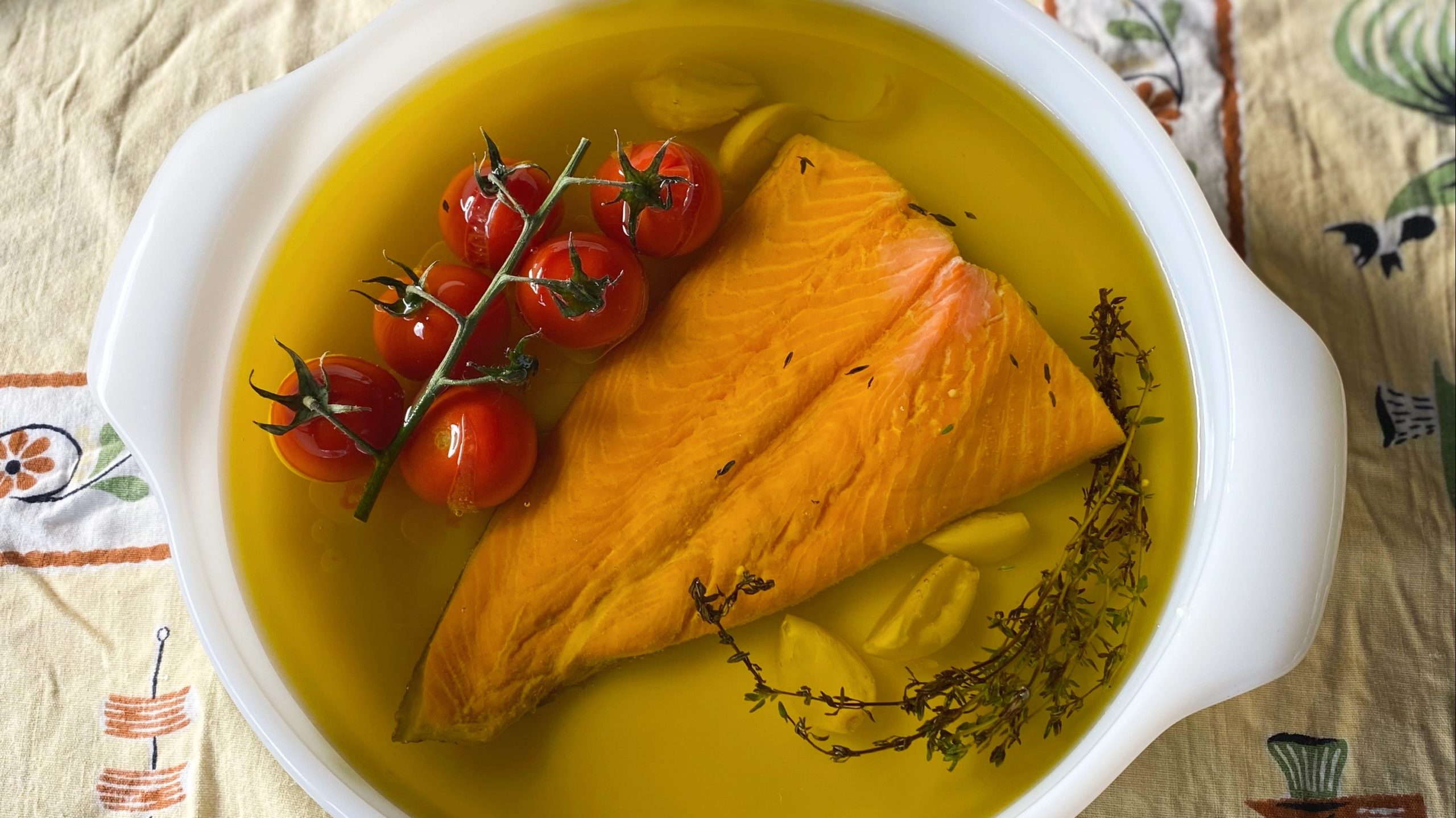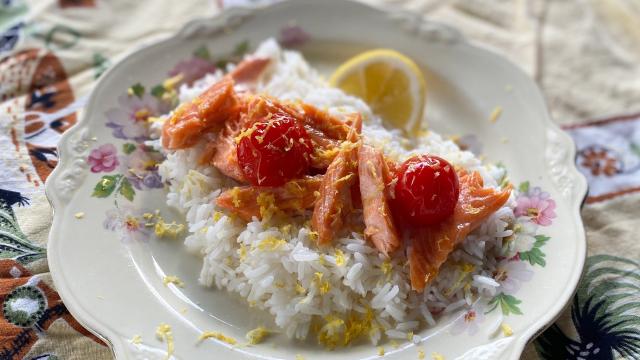I only have one fitness goal for 2022: Get real swole. This, of course, involves eating a lot of protein, and sea creatures are a great source. For most of my life, fish was something that was battered in cornmeal and deep fried. If I had to pick one fish to eat for the rest of my life, catfish, prepared as I’ve just described, would be it, but’s not exactly a convenient (or “healthy”) preparation method, and getting a lot of convenient protein every day is going to be a key part of journey.
Even if you’re not trying to see major gains this year, knowing how to cook fish and shellfish is valuable if you like eating those things. But outside of frying, cooking seafood in general can be a little daunting for those who don’t have a lot of experience with them. Both are fairly expensive and overcook fairly easily, which can create a small-to-medium amount of anxiety.
Enter olive oil poaching, an extremely forgiving, gentle, and luxurious way to cook all kinds of seafood. It’s a simple method: Cover your seafood in olive oil, add any aromatics you desire, then cook at a low temperature — either on the stove or in the oven — and let the oil slowly and tenderly cook your fish, shrimp, or whatever other sea creature you fancy. This low-temp method lets you cook fish with less anxiety, as it will take whole minutes, rather than mere seconds, to go from “perfectly flakey” to “rubbery and gross.”
There are two ways you can poach seafood in olive oil — in the oven or on the stove. I do fish in the oven and shellfish on the stove; the latter cooks quite quickly, and I like to be able to fish it out as soon as it’s ready. For the oil, get something mid-range; you’re going to taste the oil, but you’re also going to be using a lot of it. With either method, you can tweak the aromatics to suit your tastes. The more aromatics you add, the more flavorful the fish will be, so keep it simple if you want the seafood’s inherent flavour to shine.

How to olive oil poach fish in the oven
As with every other piece of fish I cook, I like to start with a quick sugar-and-salt cure to give it a firm, pleasant texture and infuse the filet with flavour (filets take best to oil poaching). This also keeps the seasoning step simple: Instead of calculating how much salt you need to add to your poaching oil, you just brine, rinse, and go.
Once the fish begins to flake, remove it from the oil with a slotted spatula (such as a fish spatula), and serve it on a bed of rice, a big pile of fresh greens, or a tangle of pasta. Drizzle the infused oil over the entire meal and garnish with fresh lemon juice and/or zest to balance out the fat. (For extra credit, poach some little tomatoes in the oil right next to the fish; they are incredible when gently mashed into rice.) To make olive oil-poached fish, you will need:
- Fish filets
- Salt
- Sugar
- Olive oil
- Any aromatics or flavorful add-ins that strike your fancy (I like thyme, sliced lemon, bay leaves, and tomatoes.)
Heat your oven to 110°C. Make a dry brine by mixing one part salt with two parts sugar by volume. A 1/4 cup of salt and 2 tablespoons of sugar should be plenty for a pound of fish. Give the filets a healthy dusting with the brine — they should look kind of glittery — then let them sit on a plate, undisturbed, at room temperature for 15 minutes.
Rinse the cure off of the fish with cold water, pat dry with paper towels, and set the filets in an oven-safe baking pan that is just big enough to hold them without anything overlapping. (The bigger your pan, the more oil you will need.) Add your aromatics and flavourings, along with enough olive oil to coat the fish by 1/8th of an inch, and place the pan in the oven.
Cook until the fish can be flaked with a fork (around 57°C-60°C), about 20-30 minutes, depending on the size and thickness of your filets. (I start checking mine 15 minutes in.) Keep in mind that the fish will continue to cook out of the oven if left in the oil, so get them out of there once you’re satisfied with the texture, or remove the whole pan just shy of them being done and use the residual heat to gently finish them off. Serve immediately.
How to poach shellfish on the stove
Shrimp, scallops, and the like cook a little faster than their finned friends, so I like to keep them on the stove where I can see them. Other than the heat source, the process is pretty similar, except we skip the brining step as shellfish is naturally pretty salty, but you can add a pinch of salt to the oil if you like yours seasoned. (If you’re strapped for time, you can poach frozen shellfish straight from the bag.) To make olive-oil poached shellfish, you will need:
- You favourite shellfish (I think shrimp are the best option here, and I’ve heard lobster is similarly excellent. Olive oil scallops are fine, but I missed the texture you get from searing.)
- Olive oil
- Aromatics and other flavourings (Toss a bunch of crush garlic and a chilli pepper in there for spicy shrimp!)
Add your fresh or frozen shellfish in a single layer in as small of a sauce pan as you can manage. Add your aromatics and flavourings, as well as enough olive oil to cover the seafood by 1/8th of an inch. Cook over low — there should be a few tiny bubbles, but do not bring it to a boil — until the shellfish begins to constrict and the centre is opaque. (Take out a little test shrimp or scallop if you need to.) For bivalves, cook them until they open up. Serve immediately.

Leave a Reply
You must be logged in to post a comment.